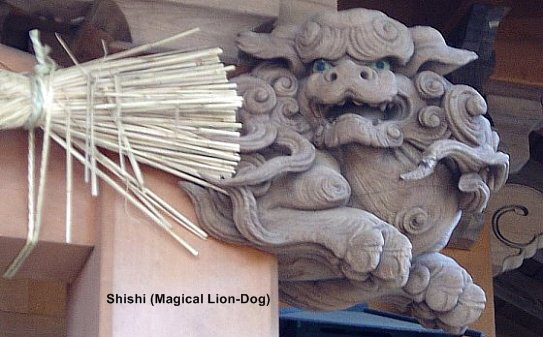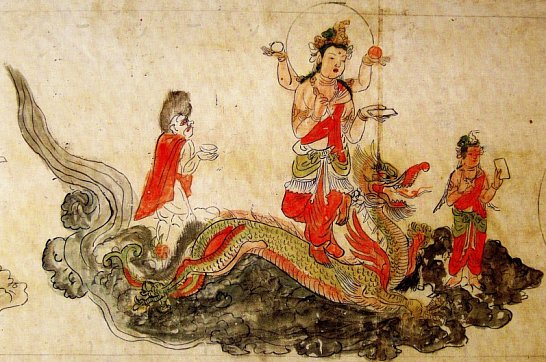Buddha Statues & Japan – November 2010
November 25th, 2010Hello Subscribers,
Knowledge updates for November 2010.
A-to-Z Photo Dictionary of Japanese Buddhism
» BAKU 獏 or 貘. Eater of Nightmares. Protective temple ornament.
https://www.onmarkproductions.com/html/baku.html
The elephant-like Baku is a mythological Chinese creature thought to devour (i.e. prevent) nightmares. Images of the Baku are commonly placed under the eaves of Japanese temples to ward off evil spirits, as are images of the magical Shishi (lion dog). Images of the Dragon are also found frequently, along with Baku and Shishi carvings, as decorative and protective architectural elements at temples, less so at shrines. Effigies of the Baku rose to popularity in the Edo period (1603 to 1868). The character for Baku (獏 or 貘) is also the Japanese name for a real-life mammal known as the tapir (an animal shaped like a pig but with a long snout). Click here for details and photos about the mythological Baku, who nearly always appears alongside the magical Shishi as a protective architectural decoration (kibana 木鼻, or decorated beam-end).
Click here for a photo tour of Shishi images in Japan.
Current & Upcoming Events in Japan & Elsewhere
» Tokyo National Museum December Schedule.
www.tnm.go.jp/en/servlet/Con?pageId=X00&processId=01
» Nara National Museum, Upcoming Exhibition Schedule.
www.narahaku.go.jp/english/exhibition/special.html
» Kyoto National Museum, Upcoming Exhibition Schedule.
www.kyohaku.go.jp/eng/index_top
» December 8. Jōdō-e 成道会. Ceremony Commemorating the Awakening of Shakyamuni Buddha. In Japan, this is the day the Historical Buddha reportedly achieved enlightenment (Skt. = nirvana). Religious services called Jōdō-e 成道会 are performed at numerous Buddhist temples.
» December 16th. Gochinza 御鎮座 Festival at Tsurugaoka Hachimangū Shrine 鶴岡八幡宮 in Kamakura. This day was reportedly the day of the shrine’s establishment in 1191. Festivities start after sunset, when firewood is burned and shrine maidens and shrine priests perform ritual dances.
» December 18th. Outdoor fair at Hase-dera Temple in Kamakura. Many outdoor stalls along the approach to the temple sell numerous items that the Japanese people typically buy in preparation for the new year.
» December 23. Emperor’s Birthday, Tennō Tanjōbi 天皇誕生日. National Holiday.
» December 31. New Year’s Eve, Ōmisoka 大晦日. Not a national holiday. Preparations begin well before Dec. 31, when Japanese households, schools, and businesses clean their habitats from top to bottom. Kadomatsu 門松 (a decoration made of pine branches and bamboo) and shimekazari 注連飾り (rope of straw with strips of white paper) are placed in front of the house). Ōmisoka usually starts when families settle down to watch special New Year variety shows on television, commonly featuring popular entertainers and singers. Toshikoshi-soba 年越し蕎麦 (long, thin buckwheat noodles) are traditionally eaten.
» January 1 (early morning). New Year’s Eve, Joya-no-Kane 除夜の鐘. At the end of each year, Japanese temples strike a large bell 108 times to symbolically awaken us from our delusions. This bell-ringing tradition is called Joya-no-Kane. Many temples allow visitors to strike the bell once and make a prayer in the early hours of Jan. 1st.
» January 1. New Year’s Day, Shōgatsu 正月. National Holiday. Established in 1948, but prior to then it was an important ceremonial day of imperial worship known as Shihō-hai 四方拝. Today most Japanese businesses are closed from Dec. 29 through Jan. 3. At the beginning of the year, many Japanese visit a shrine to express gratitude for divine protection during the past year and to gain the blessings of the local kami for ongoing protection in the coming year. This first shrine visit of the new year is called Hatsumode 初詣. At Tsurugaoka Hachimangū Shrine in Kamakura alone, some two million people visit the shrine over three days during the New Year holiday. Japanese also make pilgrimages devoted to the Seven Lucky Gods during the month of January.
» For a larger list of Japan’s major holidays, see Mr. Kondo Takahiro’s web site.
asahi-net.or.jp/~QM9T-KNDU/annualev.htm
End Newsletter








